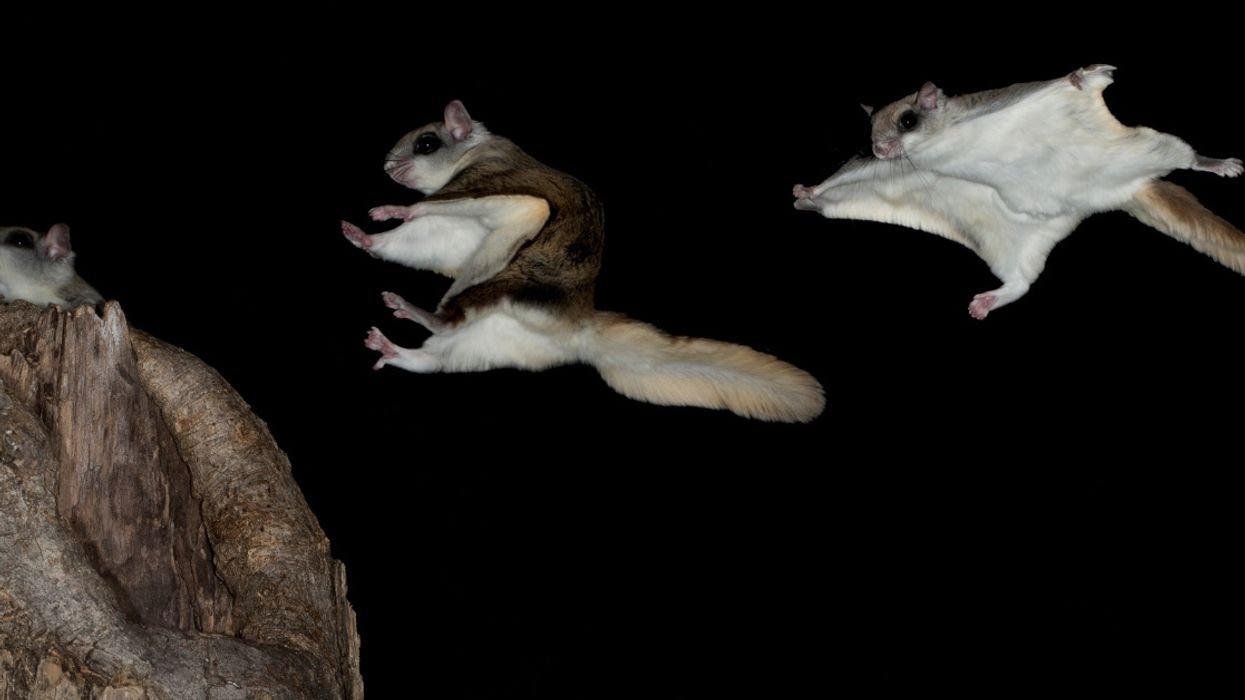Animals never cease to amaze us with all of their unique abilities.
Will we truly know everything there is to know about the fascinating world of the animal kingdom?
A luminescent pink entity streaked through a Wisconsin forest, leaving one professor wondering if it was something otherworldly. Turns out, it was better than that.
A forest ecologist was examining lichen using ultra violet light when he noticed the pink flash was emanating from a North American flying squirrel, confirming that these aerodynamic critters do glow pink under UV light.
The phenomenon is considered by Nature to be a rare example of fluorescence in mammals.
Jon Martin, the Northland College professor who witnessed the pink flash told Newsweek he instantly identified the source of the familiar chirping he heard at a bird feeder.
"One evening, I hear the unmistakable chirp of a flying squirrel at our bird feeder."
"I point the light at it and bam! Pink fluorescence."
Bam!
Take a look at this tweet that Texas A&M University graduate student Allie Kohler posted.
Martin enlisted then-undergraduate student Kohler to head a team of researchers to learn more about the pink glow phenomenon Kohler described as:
"seemingly unnatural in the natural world."
The team included Allison M Kohler, now a graduate student at Texas A&M University; Dr. Jonathan G Martin, Associate Professor of Forestry; Dr. Erik R Olson, Assistant Professor of Natural Resources and Dr. Paula Spaeth Anich, Associate Professor of Natural Resources; all at Northland College, a private college in Ashland, Wisconsin that focuses on the environment and sustainability.
They found that after studying 135 museum specimens across 3 squirrel genera, only the genus Glaucomys had the capability of illuminating cotton candy pink under UV light. Dr. Anich likes to "highlight the importance of museum studies and what knowledge they hold."
Attempting to study animals in the wild can take years and many more resources than studies conducted on museum specimens while often yielding the same results.
While the reason for their furs turning into a pink hue is uncertain, the researches surmised it could serve as a recognition feature among the species or protection from avian predators.
Or, they could simply be flaunting their spectacular feature for us humans.
Whatever the reason, Erik Olson, an assistant professor at Northland is impressed by the wonders of nature.
"I think these kind of discoveries just cause us to pause in wonder at the world around us."
Kohler added:
"There is so much that is waiting to be discovered in this world, hiding right in front of us in plain sight. Sometimes, it just takes looking at the world in a different way to see things that haven't been seen before."
We think their pink furs are fierce.
Now that we know about Rocky, what about her Moose-friend?
Wonders never cease, indeed.
The study was originally published as "Ultraviolet fluorescence discovered in New World flying squirrels (Glaucomys)" in the Journal of Mammalogy. You can read the full article here.








 @jessetyler/Instagram
@jessetyler/Instagram @
@ @traveling_gal_712/Instagram
@traveling_gal_712/Instagram @kamillaedwards/Instagram
@kamillaedwards/Instagram @pastrywithjenn/Instagram
@pastrywithjenn/Instagram @jguttler/Instagram
@jguttler/Instagram @qurarshah/Instagram
@qurarshah/Instagram @ruthbl921/Instagram
@ruthbl921/Instagram @acsanti/Instagram
@acsanti/Instagram @aulanirenee/Instagram
@aulanirenee/Instagram @x.seymaaa.x/Instagram
@x.seymaaa.x/Instagram @morganpiriou/Instagram
@morganpiriou/Instagram @modernfamily/Instagram
@modernfamily/Instagram







 @GovPressOffice/X
@GovPressOffice/X
 @thegrinningowl/Bluesky
@thegrinningowl/Bluesky @macstheknife/X
@macstheknife/X @JohnDuran/X
@JohnDuran/X